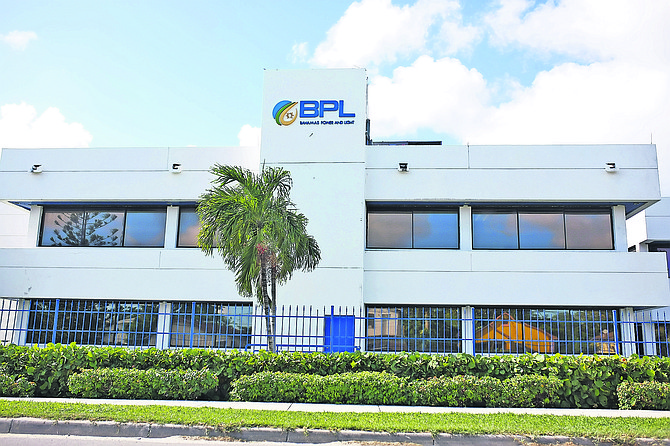By NEIL HARTNELL
Tribune Business Editor
nhartnell@tribunemedia.net
Bahamas Power & Light’s (BPL) chairman yesterday disclosed that parts of its grid “are not working optimally” due to the utility’s delayed $535m bond refinancing.
Dr Donovan Moxey told Tribune Business that the continued wait to place BPL on a more sustainable financial footing had left it without the planned funding to upgrade its aged transmission and distribution (T&D) infrastructure.
While BPL was “very comfortable” that its total $125m investment in new engines had dealt with New Providence’s generation issues, he indicated that the island was still likely to see localised power outages - as opposed to the regular island-wide blackouts of last summer - until the T&D network can be enhanced.
Dr Moxey said the continuing COVID-19 fall-out meant the timing of BPL’s bond placement remains uncertain, with the utility seeking to “balance the need for capital with the cost of capital” so that repayment (interest) costs are such that they do not “over burden” Bahamian households and businesses.
He also disclosed that BPL is awaiting a decision from the Minnis administration on whether it wants to continue the COVID-19 bill deferral relief initiative, having announced that customers on the initial version have until July 28 to bring their accounts current or work out a payment plan due to its expiry.
Conceding that electricity supply is “a necessity, not a luxury”, Dr Moxey urged businesses and households struggling amid the economic crisis caused by COVID-19 to “not leave to chance” whether they will be disconnected but instead contact the utility to arrange a payment plan.
“The challenges many people have been seeing over the last several weeks are attributed to transmission and distribution,” he told Tribune Business of recent outages. “We’ve had electrical storms that have disrupted power, and some components in the network that have failed.
“We’re replacing transformers and other components that we’re looking at changing out. Those are the components that are most faulty and we’re looking to switch those out if we can. We’re just being very methodical in our approach, given the limitations in funding from a transmission and distribution perspective.”
Dr Moxey confirmed that these limitations had resulted from the delayed placement of BPL’s $535m rate reduction bond (RRB) refinancing, which was intended to provide funding for a multi-million dollar overhaul of substations, transformers, power lines and poles.
“When the funding was delayed a number of things were delayed with that,” he added. “Transmission and distribution and infrastructure investment is very expensive... As a result of not having the funds, we are being very methodical and deliberate in working out the areas and critical components we need to fix.
“There are certain parts of the network not working optimally, but our commitment is to get customers back on line once an outage happens as quickly as possible.”
Dr Moxey said international capital market turbulence as a result of COVID-19 made it impossible to predict when BPL and its advisers, including Citibank as lead arranger and placement agent, would be able to place the refinancing that is seen as critical to placing the state-owned utility on a stable footing.
He added that BPL, as well as the Government, were determined not to impose high interest rates and repayments “on the backs of the Bahamian people” even though investors are currently likely to be demanding a premium for the perceived extra risk involved.
As for BPL’s generation assets, Dr Moxey said the acquisition of the 132 mega watts (MW) of new capacity at Clifton Pier, combined with the 35 MW General Electric (GE) turbine at its Blue Hills plant, had equipped the New Providence operation with 340-360 MW of available supply.
This compared to 260 MW peak demand, which he added gives BPL around 100 MW of breathing room and excess capacity should any engine fail. “In layman’s language, that means that if we have two to three generation assets running, we have two to three back-ups available,” he explained.
While BPL has unveiled plans to restart disconnecting non-paying customers, Dr Moxey said it was still awaiting a decision from the Government on whether the COVID-19 Relief Programme will continue.
“The Government initially came to us and asked us to put a programme in place for three months,” he added. “We did, and we are certainly more than willing to do what the Government sees as necessary to alleviate the burden on the consumer. We have no problem putting that deferral in place if the Government deems it necessary.”
The BPL chairman declined to comment on how the utility’s financials have been impacted by the three-month suspension of residential disconnections through the COVID-19 pandemic’s peak.
Revenues and accounts receivables are likely to have taken a significant hit, and BPL is now warning that customers who were were more than $500 in arrears for 90 days prior to April 1 are candidates for immediate disconnection unless they become current or agree a payment plan.
Those who accumulated their arrears during the COVID-19 lockdown, and customers who were on the bill deferral initiative, now have 21 days to either become current or work out a payment plan - a period that ends on July 28.
Emphasising that BPL would only cut customers off as a last resort, Dr Moxey urged both businesses and residential customers in difficulty to contact the utility and work out a payment plan.
“We understand everyone is having a challenging time,” he said. “We need electricity. It’s a necessity, not a luxury, so we want to work with you. Come in and sit down, and let’s determine what’s an appropriate payment plan. We’re very conscious of that. Don’t leave it to chance and hope you don’t get cut off.”




Comments
Use the comment form below to begin a discussion about this content.
Sign in to comment
Or login with:
OpenID